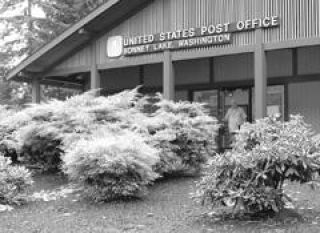The approval process for a Bonney Lake ZIP code has been started by post office
By Dennis Box
The Courier-Herald
Bonney Lake is about to take a giant step forward in the "Mother May I" world of getting a ZIP code from the United States Postal Service.
The city has been trying for many years to get its own code, separate from Sumner.
Residents of Bonney Lake and the surrounding area have a Sumner mailing address and ZIP code, 98390, which causes all sorts of confusion and headaches for the city and local businesses.
The Bonney Lake post office is an annex of the Sumner post office.
Guy Bennett, manager of address management systems in Seattle for the USPS, reported the process for approving a ZIP code for the Bonney Lake has been officially started.
"I think we have a pretty good case," Bennett said. "I want to be sure it will be successful. There must be a public desire and an internal need for processing. We're are trying to get things going."
The driving force behind the granting Bonney Lake a ZIP code is growth, inside and all around the city. Homes are being built at a blinding pace and 1,000 people move into the area each year.
Bonney Lake is commonly referred to as the fastest growing city in Pierce County, the second fastest in the state behind Issaquah.
But for the folks who live in Bonney Lake, the desire for a ZIP code means more than the numbers of cars and people driving up the hill.
"It is a city identity issue," Councilman Dave King said. "For long time Bonney Lake has not been thought of as a city. Many people couldn't even point to where Bonney Lake is on map. This will separate us from Sumner. Psychologically it's a big step forward and as a matter of citizen pride it's important to have our own ZIP code."
The steps required in getting a ZIP code approved, according to Bennett, begins with producing about a 25-page proposal complete with pictures of the area, the number of routes, what the delivery problems are and the solutions.
That proposal must first be approved internally at the Seattle district office of USPS.
From Seattle it moves on to the Denver regional office and finally back to USPS headquarters in Washington D.C.
"We've been trying to get a ZIP code ever since I've been mayor, seven years, even before that," Mayor Bob Young said. "That was one of my campaign promises. We have tried for years."
Bennett stated the internal review should be completed by mid-November and the next two steps could take until mid-December.
"It has to be approved on all levels before a ZIP code is assigned," Bennett said. "There are only so many ZIP codes available, and our people at headquarters are picky in this area. They have to be. There are places in the country, like in Atlanta, that are growing so fast they had to do more than add two digits. The first three numbers were changed, that's the number for the sectional center facility."
ZIP codes were first experimented with by the USPS in 1943. It was called a zoning address system and was implemented because so many experienced postal workers went off to fight in World War II.
It was thought to be an easier system for postal employees to separated the mail.
In July of 1963 the Zoning Improvement Plan, or ZIP codes, was adopted by the USPS. A five -digit code was assigned to every address in the country.
The ZIP code system became mandatory in 1967.
Dennis Box can be reached at dbox@courierherald.com.


